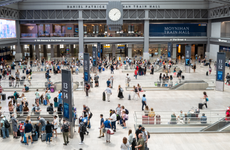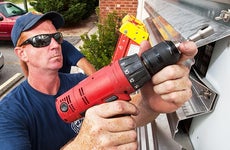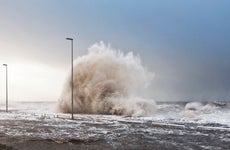How to financially prepare and recover from a natural disaster

The Bankrate promise
At Bankrate we strive to help you make smarter financial decisions. While we adhere to strict , this post may contain references to products from our partners. Here's an explanation for .
Key takeaways
- Preparing financially for natural disasters is important — especially if you live in an area prone to severe weather events — but the mental and physical toll faced can be an even greater challenge to overcome.
- Credit cards can help you cover emergency financial needs, but they shouldn't be a substitute for an emergency savings fund.
- Earning rewards on emergency spending can be a bonus, but prioritize other features based on your needs, like 0% introductory APR or instant approval for new card applications.
Nobody wants to think about — let alone prepare for — having their lives upended by a natural disaster. But with natural disasters and extreme weather events on the rise, a growing number of people are finding themselves forced to face this scenario. According to Bankrate data, 57 percent of U.S. adults surveyed say they have incurred costs due to an extreme weather event over the last 10 years.
Ultimately, the more you can do to prepare for a natural disaster, the more quickly you might be able to recover.
“Disaster recovery is an incredibly complex process,” says Kate Bulger, senior director of business development at Money Management International (MMI). “We help people with the financial recovery part.”
MMI is a nonprofit organization that helps people struggling financially after a natural disaster, providing free resources, counseling and assistance through Project Porchlight. Bulger’s work with Project Porchlight has made her very familiar with the financial struggles people experience after natural disasters — which is why she was able to help us create this financial guide to disaster preparedness and recovery.
What to expect after a natural disaster
If your community were to experience a natural disaster, you might expect damaged property and downed power lines. But you might not expect to find yourself struggling to find childcare, covering expenses while requesting reimbursements or dealing with emotional trauma.
Here are three ways a natural disaster might affect your life.
Disrupted routines
“Part of what makes disaster so tremendously difficult to recover from is that you don’t just lose your home,” says Bulger. “Schools are out, so suddenly people have their kids all the time. People’s jobs are often impacted. Transportation is impacted. You may be required to temporarily relocate.”
All of these disruptions add up, and can make natural disasters not only more expensive but also more emotionally costly. “You lose the things within your community that you use to ballast and support your life,” says Bulger.
Hidden costs
In addition to the cost of rebuilding after a disaster, you’ll need to be prepared for hidden expenses associated with the day-to-day cost of living. If you no longer have access to a kitchen, for example, you may need to purchase more prepared food. You may also find yourself paying extra for hotel rooms, rental cars or laundromats.
All of these costs add up, and not all are covered by insurance. Even with sufficient insurance coverage, you’ll likely need to pay your own expenses before filing a claim for reimbursement. “With disasters[,] people often need to pay out-of-pocket before getting reimbursed,” says Bulger. “And those reimbursements can take a long time.”
Physical and emotional trauma
It’s important to prioritize your mental health — especially when you’re dealing with the physical, financial and emotional burdens associated with a natural disaster. “Disasters are incredibly traumatic experiences,” Bulger explains. “And trauma can make it even more difficult to go through the recovery process.”
Whether you’re trying to cope with relocation or worrying about how you’re going to cover the costs of rebuilding, a good therapist or counselor can give you the space to talk through your fears and process your loss.
While you may be able to access free mental health resources, you should also be prepared to include self-care as one of the hidden costs of recovery — not only for yourself, but also for the other members of your family.
How to prepare financially for a natural disaster
If you live in an area that regularly experiences floods, wildfires, earthquakes or other disasters, you may already know about basic disaster preparedness methods — securing bookshelves to the wall, for example, or making sure you have a go bag packed with food, blankets and financial documents in case of an emergency evacuation.
Here are three additional ways to prepare for a natural disaster, if you want to be financially ready.
Boost your credit score
If you’re planning on using credit cards to help you recover from the costs of a natural disaster, you’ll want to start improving your credit score now. Building good credit can help you access better credit cards and can help you apply for a personal loan, if necessary.
Try to build good credit before disaster hits, so that it can act as a buffer when things go wrong. If it does, consider credit counseling to get back on track. Look for a counselor with experience in disaster recovery.
“The average consumer loses about 25 points on their credit score after a disaster,” says Bulger. “When people work with financial counselors, they can gain 25 points in the two years after a disaster.”
Build your emergency fund
In addition to building your credit score, you’re also going to want to build your emergency fund. Even if you can only afford to put away $25 every month, that cash is going to add up. More importantly, it’s going to be there when you need it, whether you’re rebuilding after a natural disaster or recovering after a medical emergency.
“It’s really important for people to plan ahead,” Bulger advises — and no matter what the future may bring, having extra money in savings can help you recover more quickly.
Expand your insurance coverage
There’s one more important step you need to take to prepare for a natural disaster: Make sure you have the right insurance coverage in place.
“Making sure you’re appropriately insured is critically important,” says Bulger. “Flood insurance, for example, is not part of the standard homeowner’s insurance policy. You have to buy it separately. Depending on where you live, you may also want to consider wildfire insurance or a hurricane policy.”
Candy Harrington, a journalist and travel writer who recently experienced a natural disaster firsthand, agrees. “Make sure you have adequate insurance coverage,” says Harrington, who is in the process of rebuilding after she and her husband lost their home to California wildfires.
“Especially make sure you have debris removal, replacement cost for contents and building code upgrades,” she says. “I know so many people who just went for the bare-bones minimum policy without any other endorsements, and they are having huge problems.”
How to recover financially after a disaster
Knowing what to expect after a disaster is one thing. Knowing how to recover is another. If you need financial assistance after a natural disaster, you may need to learn how to navigate a complex system of organizations and resources. And although help is available, not everybody knows when or how to ask for assistance.
“Recovery is an incredibly bureaucratic process,” Bulger explains. “If you don’t know how to navigate the recovery system, it can be very difficult.”
Here are three steps you can take to make your disaster recovery a little easier, and to get back on a solid financial footing as quickly as possible.
Get help
One of the best ways to restore financial stability after a natural disaster is to ask for help — whether that means asking a friend if you can sleep on their couch for a few days or asking your credit card issuer if you can take advantage of a hardship program.
That’s where services like Project Porchlight come in. “People need to know that they can come to Project Porchlight after a disaster,” says Bulger. “And they need to know that it’s free.”
Access resources
Whether you work with a disaster relief counseling service like Project Porchlight or go it alone, it’s important to know how to access financial resources after a natural disaster. You may want to apply for FEMA assistance, for example. Check state and local resources to see what else is available.
Be prepared for this process to take time. “You’ll need to fill out a lot of forms,” says Bulger. “And if you don’t know which forms to fill out, you could lose out on aid money or insurance.”
Gather financial documents
Find somewhere to safely store all of your financial documents in one spot, whether that means a fireproof lockbox, a safe deposit box or somewhere else safe. Make digital copies of your documents and records and store them on a USB drive for added security.
Take stock of your belongings
Make a household inventory list of your possessions, especially any valuables. Include photos and any pertinent documents or details you’ll need if you have to file an insurance claim.
Tips for using credit cards to cover emergency weather-related expenses
Even with a fully-funded emergency fund, you may need to use credit cards for expenses related to natural disasters. Below are some best practices to follow when using credit cards for emergencies.
Use credit wisely
Even if you get all of your forms filled out as quickly as possible, there may be a gap between when you request financial assistance and when you receive it. Many people fill that gap with credit cards. “If you use credit right, it can be an incredibly useful tool,” says Bulger. “You may need to take on a little debt now, but you can make a plan to make progress on your debt later.”
If you use your credit cards to cover expenses after a natural disaster, make sure you keep up with your payments. Even making the minimum payment on time can help you maintain a positive credit history.
As soon as possible, contact your credit card issuer. “After disasters, let your credit card companies know,” says Bulger. “Every company has some kind of compassionate assistance option, and as soon as someone tells them they’ve been in a natural disaster, they’ll offer whatever they can to help out.”
Automate card payments
Stay on top of your payments by setting up automatic monthly payments through your card account. Automating payments, even if for the minimum payment requirement, will help you avoid missed payments and costly late fees.
Consider your needs
Use cards that align with your financial needs. An intro 0% APR card is ideal for significant emergency expenses that will require a longer period of time to pay off. If you need access to new credit quickly, look for credit cards that allow instant access upon approval.
Use no-fee cards for emergencies
If you don’t plan on using your new card for purchases outside of disaster recovery, look for cards with no annual fee so that there’s no carrying cost for holding the card.
Ask for a limit increase
If you already have an emergency card to use, you may be able to request a credit limit increase from your card issuer. Be aware, however, that credit limit increase requests often require a credit check, similar to when you applied for the card.
Best credit cards to have for natural disasters
When you’re recovering from the financial and emotional effects of a natural disaster, having the right credit card in place can help you save on food, supplies, home repairs and unexpected travel. Here are three different types of credit cards to consider, before disaster strikes.
Cards that reward post-disaster purchases
Whether you’re rebuilding your home after a wildfire or restocking your refrigerator after a three-day power outage, it’s a good idea to have at least one credit card that rewards post-disaster purchases.
If you live in an area with the potential for home-damaging storms, having a credit card that rewards home improvement could earn you additional perks while you wait for your insurance company to reimburse your purchases later on. Some cards offer as much as 5 percent cash back at retailers like Lowe’s or Ikea.
The Bank of America® Customized Cash Rewards credit card, for example, earns 3 percent cash back in one eligible category of your choice, including home improvement, gas stations, online shopping, dining, travel and drugstores. You’ll also earn 2 percent cash back at grocery stores and wholesale clubs (up to $2,500 per quarter), then 1 percent back on all other purchases.
Cards that offer travel protections
While we usually turn to travel credit cards for vacations, the travel insurance, rental car insurance and other protections those cards offer can come in handy in emergencies too. That’s because many people don’t think about the importance of trip cancellation coverage or the possibility of an emergency evacuation due to an unexpected natural disaster.
For example, for a $95 annual fee, the Chase Sapphire Preferred® Card offers up to $10,000 per person in trip cancellation and interruption insurance, and excellent rental car insurance — all of which can come in handy in an emergency situation.
That said, make sure you read any insurance documentation carefully to find out exactly which circumstances are covered, as natural disasters may be excluded in some cases. Consider applying for additional travel insurance if your credit card doesn’t provide the coverage you need.
0% intro APR cards
If you’re paying for your post-disaster expenses out of pocket, choosing a 0 percent APR card can save you a lot of money on interest charges. Many of today’s best balance transfer cards offer more than a year of 0 percent intro APR on purchases.
The Wells Fargo Reflect® Card, for example, offers 21 months with no interest on purchases (0% intro APR for 21 months from account opening on purchases and qualifying balance transfers; 18.24%, 24.74%, or 29.99% Variable APR thereafter). This window gives you time to begin rebuilding, request reimbursement from your insurance company and pay off your credit card balance interest-free.
Cards you can use instantly
Typically, when you’re approved for a new credit card, you have to wait a week or longer to receive your card in the mail before you can begin using it. On the other hand, some credit cards offer instant use upon approval, which could be helpful if you need to access new credit quickly for an emergency.
As an example, the Blue Cash Preferred® Card from American Express comes with an instant card number upon approval (for select applicants). The card earns 6 percent cash back on up to $6,000 annually (then 1 percent) at U.S. supermarkets and on select U.S. streaming services. You’ll also earn 3 percent cash back on transit, 3 percent on U.S. gas station purchases and 1 percent back on other purchases. Be aware that the Blue Cash Preferred has a $0 intro annual fee for the first year, but charges a $95 annual fee after that — so make sure its rewards structure will make sense for you after your emergency situation resolves.
For iPhone users, the Apple Card* gives you instant access for card spending through a virtual card number you can connect to Apple Pay. The Apple Card has no annual fee and earns 3 percent back when you use Apple Pay at Apple and other select merchants, 2 percent back on other Apple Pay purchases and 1 percent back on other purchases.
As one of the largest retailers with thousands of locations, Walmart may be the best or quickest option for groceries and other immediate physical needs following a natural disaster. The Capital One® Walmart Rewards® Card* offers instant access at all Walmart store locations and on Walmart.com through Walmart Pay. You’ll also earn 5 percent cash back at Walmart.com, including pickup and delivery, 2 percent cash back in Walmart stores, at restaurants and on travel and 1 percent cash back everywhere else Mastercard is accepted.
The bottom line
Natural disasters can be devastating in so many ways, including financially, which is why knowing what to do before disaster strikes is so important. If you find yourself in a bind after a disaster, services like Project Porchlight can provide counseling to help you get back on your feet.
If you use credit cards to cover the cost of natural disasters, make sure you let your credit card issuer know. And consider taking advantage of credit card hardship programs that can help you restore financial stability without damaging your credit score.
*The information about the Apple Card and the Capital One® Walmart Rewards® Card has been collected independently by Bankrate. The card details have not been reviewed or approved by the issuer.
Related Articles

Worried about a potential recession? Here’s 9 steps to prepare your finances now


